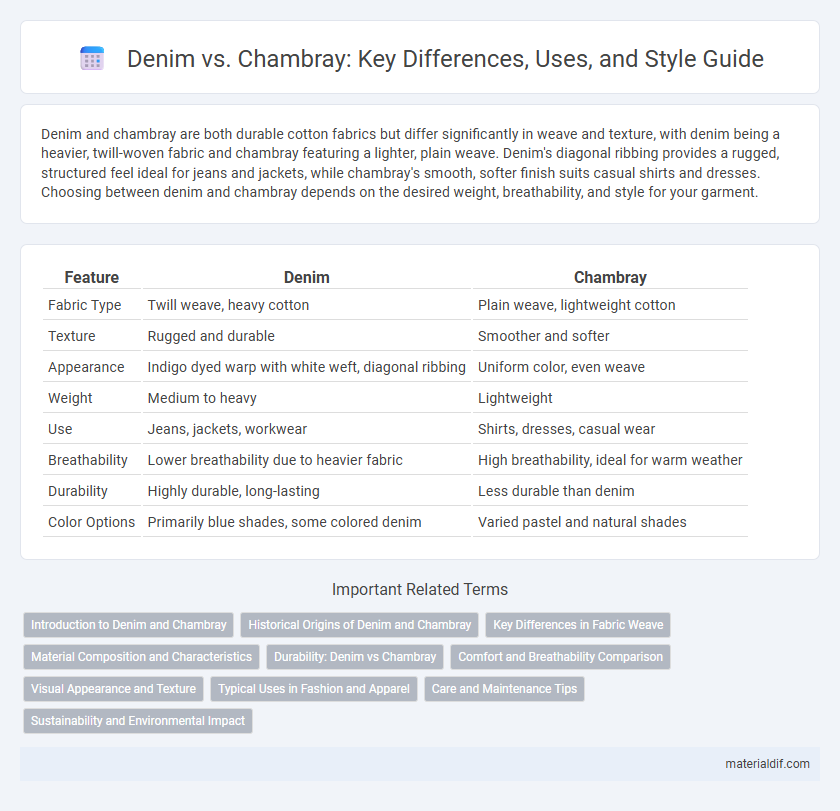Denim and chambray are both durable cotton fabrics but differ significantly in weave and texture, with denim being a heavier, twill-woven fabric and chambray featuring a lighter, plain weave. Denim's diagonal ribbing provides a rugged, structured feel ideal for jeans and jackets, while chambray's smooth, softer finish suits casual shirts and dresses. Choosing between denim and chambray depends on the desired weight, breathability, and style for your garment.
Table of Comparison
| Feature | Denim | Chambray |
|---|---|---|
| Fabric Type | Twill weave, heavy cotton | Plain weave, lightweight cotton |
| Texture | Rugged and durable | Smoother and softer |
| Appearance | Indigo dyed warp with white weft, diagonal ribbing | Uniform color, even weave |
| Weight | Medium to heavy | Lightweight |
| Use | Jeans, jackets, workwear | Shirts, dresses, casual wear |
| Breathability | Lower breathability due to heavier fabric | High breathability, ideal for warm weather |
| Durability | Highly durable, long-lasting | Less durable than denim |
| Color Options | Primarily blue shades, some colored denim | Varied pastel and natural shades |
Introduction to Denim and Chambray
Denim is a sturdy cotton twill fabric characterized by a diagonal ribbing pattern, typically dyed with indigo on the warp thread and white on the weft, creating its signature blue hue and durability, widely used in jeans and jackets. Chambray is a lightweight plain weave fabric made from colored warp and white weft threads, offering a softer texture and breathable feel, often used in shirts and summer apparel. Both fabrics originate from cotton but serve distinct purposes due to their weave patterns and weight differences.
Historical Origins of Denim and Chambray
Denim originated in the 17th century French town of Nimes, where it was originally called "serge de Nimes," evolving into the durable cotton twill fabric used in jeans today. Chambray, with roots in the Belgian town of Cambrai, emerged as a lightweight plain-weave fabric, favored for its breathable and smooth texture. Both fabrics hold distinct historical significance, with denim linked to workwear and chambray often preferred for casual, summer clothing.
Key Differences in Fabric Weave
Denim features a twill weave, characterized by diagonal ribbing that enhances durability and gives it a heavier texture ideal for jeans and workwear. Chambray uses a plain weave with a simple over-under pattern, resulting in a lighter, softer fabric with a smooth surface often used in casual shirts. The distinct weaving techniques directly impact the weight, texture, and typical applications of each fabric.
Material Composition and Characteristics
Denim is a sturdy cotton twill fabric characterized by its diagonal ribbing, typically dyed with indigo to create a blue color, which provides durability and resistance to wear. Chambray is a plain-weave fabric made from a blend of cotton or cotton-polyester, featuring a lighter, softer texture and a more breathable quality due to its loose weave. Denim's heavier weight and rugged texture contrast with chambray's smooth surface and lighter body, making each suitable for different apparel applications.
Durability: Denim vs Chambray
Denim is woven with a twill weave, making it thicker and more durable than chambray, which uses a plain weave and lighter cotton yarns. The diagonal ribbing in denim enhances its strength, ideal for heavy-duty workwear, while chambray's softer texture suits casual and lightweight clothing. Denim's robust construction resists wear and tear better, offering longer lifespan and superior durability compared to the more delicate chambray fabric.
Comfort and Breathability Comparison
Denim, typically heavier and thicker due to its twill weave, offers durability but less breathability compared to chambray, which is lightweight and woven with a plain weave, enhancing air circulation. Chambray's soft cotton fibers provide superior comfort in warm climates, making it ideal for breathable, casual wear, while denim's robustness suits cooler weather and rugged use. Both fabrics vary in comfort and breathability based on weight and weave, with chambray favored for its light, airy feel and denim for its structured resilience.
Visual Appearance and Texture
Denim features a diagonal twill weave that creates a distinctive ribbed texture and a rugged, durable appearance, often dyed with indigo for a deep blue color. Chambray, woven with a plain weave, displays a smoother surface and lighter weight, characterized by its subtle, speckled look due to white weft threads interlaced with colored warp threads. The visual contrast between denim's pronounced texture and chambray's fine, soft finish defines their distinct aesthetic and tactile qualities.
Typical Uses in Fashion and Apparel
Denim, known for its durable twill weave and indigo dye, is typically used in jeans, jackets, and heavy-duty workwear due to its rugged texture and long-lasting qualities. Chambray, a lighter plain-woven fabric made with colored warp and white weft yarns, is favored for casual shirts, dresses, and summer apparel because of its breathable and soft feel. Both fabrics are staples in fashion but serve different functions: denim provides sturdy outerwear while chambray offers comfortable, lightweight clothing options.
Care and Maintenance Tips
Denim requires washing inside out in cold water to preserve color and avoid excessive fading, while chambray benefits from gentle washing to maintain its lightweight texture and prevent fraying. Air drying is recommended for both fabrics to minimize shrinkage and fabric wear, with denim often needing occasional spot cleaning to extend garment lifespan. Storing denim and chambray in a cool, dry place helps prevent mold and fabric deterioration, ensuring longer-lasting durability.
Sustainability and Environmental Impact
Denim and chambray differ significantly in sustainability and environmental impact due to their production processes and material composition. Denim, often made from heavier cotton twill, typically requires more water, energy, and chemical treatments during dyeing and finishing, increasing its ecological footprint. Chambray, being a lighter plain-weave fabric, generally involves less resource-intensive production, making it a more eco-friendly choice in sustainable fashion.
Denim vs Chambray Infographic

 materialdif.com
materialdif.com